A lifetime of Homes, Houses and Places: Part I
The Early Years:
1936 to 1945(1)
Here is a life time of houses, homes and places where I have lived. My life began in Iowa where I was born and concludes in Denver, Colorado where I will probably be living when it comes time to depart this world. As I write about these homes and places over the years, I am essentially tracing a chronological history of my life.
I know that the list of places in the early years, particularly those from when I was born till we moved from Milwaukie to the McKenzie River valley east of Springfield is incomplete. I just do not recall all of the places we lived when we first came to Oregon from Iowa in the fall of 1940. However, I have a record of addresses for all the homes I lived in from 1946 to the present. These addresses are recorded in my “Birds of America,” that I received on my 10th birthday (February 7, 1946). For some reason I did not record the place where Mary Lee and I first lived after our marriage in 1963. I also do not have the address of the apartment house where I lived between the fall of 1961 and March, 1963. I do know that it was on Vista Avenue in south west Portland.
What I do recall is having to complete a list of all of the places we had lived in order to pass a security check after I was stationed at Walter Reed Army Medical Center in 1958. In our early years, Mom and Dad moved around a lot. We lived in an apartment house on the west side of Portland after we first came to Oregon. I believe this was temporarily with Ted and Esther Mills. Ted was a friend of Dad’s and was the person who had gotten us to move from Woodbine, Iowa to Oregon. At some point in these first months/year after moving to Oregon we lived in a motel in the Park Rose area of Portland along east Sandy Boulevard.
1936-1940: Woodbine, Iowa
I was born in Woodbine, Iowa and spent the first 4 ½ years of my life there. Mom has said that we originally lived in a small house in the southwest part of Woodbine. It was a bit of a walk from there to Grandmother Anderson’s place and even further to Grandmother Turner’s home. Dad had to walk about the same distance to work at the grocery store down on main street.
I am not sure when we moved from that location to the one next to Grandmother and Grandfather Anderson. Nor can I confirm that location now because no one of the previous generation is still living. The family story is that Mom and Dad bought a small house next door to the senior Anderson’s place. We were separated by a lilac hedge, but there was a gap in it where we could go from our back door up to the side door on their large home. Our house was small and I do not remember anything about it, though there is a picture of Mary and I sitting on the front step when we were about 2 and 3.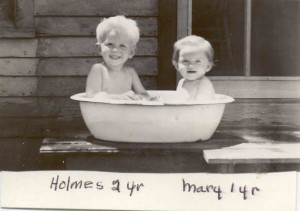 There is also a picture of us in a wash-basin in the back yard. Mom liked to take pictures of us bathing in the yard. I have another, nearly identical photo taken about a year later with Mary and I in the same tub.
There is also a picture of us in a wash-basin in the back yard. Mom liked to take pictures of us bathing in the yard. I have another, nearly identical photo taken about a year later with Mary and I in the same tub.
I really have only one vivid memory of that home: one day Mom sent me over to Grandmother Anderson’s to borrow a cup of vinegar. I gleefully went over and made the request which Grandmother Anderson gladly filled. On the way back I decided that I really needed to know what vinegar smelled like, so I placed my nose close to the top of the small pitcher or cup and took a healthy sniff – whooboy!! I still remember the sensation of the top of my head coming loose. I do not know if I dropped or spilled any of the vinegar, but I certainly remember that whiff!
1940-1941: Portland, Oregon and Dexter, Oregon
Dad left Woodbine in the summer of 1940, driving a car in a convoy from Omaha to Portland Oregon for Ted Mills, a friend from Woodbine. In the period before the War it was common practice to buy cars in the midwest which was closer to where they were built and then drive them to the west coast where they commanded a higher price.
Ted had a great entrepreneurial talent and was involved in a number of different businesses over the years that Mom and Dad knew him and Esther. They kept up with each other all of their lives, in fact I would say that Ted and Esther Mills were perhaps the longest and best friends that Mom and Dad had besides Bert and Dave Brown.
Back to the story: Dad drove to Oregon and found some work in the Portland area. He settled in and sent for Mom and we three children: I was 4 ½, Mary was 3 and a few months, Bill (or William as he was called then) was just shy of 2. Mom was 23 and took care of we three toddlers on the 3 day train ride from Omaha, Nebraska to Portland, Oregon. Again, I do not remember any of the events of that trip but Mom has said we stopped in Cheyenne and got off the train for a bit.Ted and Esther were living in a very nice apartment on the west side on Vista Avenue just a bit south of Burnside. There was a monkey puzzle tree in the parking or in the little space between the street and the front of the apartment.
Dad eventually got a place out in the Park Rose district along Sandy Avenue. We were probably there for only a month or so, I believe it was a motel. Our stay here was very brief.
Springfield and Dexter, 1940-1941
Next we moved south to the Springfield area where Dad had gotten a job in one of the Giustina saw-mills. For a very brief time we lived in a motel on Main Street in Springfield. The most impressionable event while there was the explosion and fire in a electrical substation just across Main Street from the motel. It occurred after dark with a loud bang and glorious huge fire.
We next moved to a small rented house on a bit of a hill above the road that went from Dexter out to the Giustina saw-mill.
This house had a porch all the way across the front and a bare dirt yard that sloped away from it toward the road. The house was located in the middle of a corn field and there was a small wood lot to the south that had a small stream running through it.I was now old enough to remember a lot about this home. Since it was up a slope from the road we had a good view of the traffic coming from the high-way up to the mill that was a bit further south of us.
Trucks were not terribly large in those days, so it was not uncommon to see one on its way to the mill with a single log filling the trailer.The wood and stream was a favorite place for the three of us (Mary, William and I) to explore and have fun. The house we were living in did not have indoor plumbing, we got our water from a well just off the front porch. Dad decided that it would be a good idea to make a deep spot in the creek where he could go to take a bath, so he built a little dam across the creek to create a pool deep enough to sit in and wash himself – so far as I recall he was the only one to use it for this purpose.
The woods and the hillside were full of snails, slugs, and lizards. Duke, our English setter and I were fond of chasing and trying to catch the lizards. We were rarely successful in catching an entire lizard, but we certainly got away with a lot of lizard tails! That summer Mom claims that we had made every lizard within a 100 yards of the house tailless.
Another favorite activity of William and I was to go into the woods and collect snails. These snails were up to an inch or so across the shell. We would collect them from among the mosses and damp leaves and put them in the pockets of our overalls. Of course when we picked them up the critters would retreat into their shells and close the flap over the opening. They were then very easy to drop into a pocket. However it was not too long before the snails revived their courage and stuck their heads and body out of the shell and began crawling along. Often we would come back to the house with several snails crawling on our overalls, much to Mom’s displeasure.
I bear to this day the scar from when my brother, William pushed me off that front porch and I landed on a broken bottle in the yard below. My left knee hit an upturned, sharp edge and sliced the skin nearly to the knee-cap. Fortunately the cut was to one side and no serious damage was done. It did hurt like hell and bled like a stuck pig. Mom bandaged me up and got the bleeding stopped, but I still have that wide scar over the right edge of my left knee-cap.
At some point, perhaps before Dad got the job with Giustinas, he worked at the Eugene Fruit Growers Association (EFGA). The Willamette and McKenzie Valleys were prime farm land with abundant rainfall, good soil and enough sunshine in the summers to produce large crops of beans, beets, corn, carrots, cherries, plums and peaches. EFGA was a major packing plant and always had need for seasonal workers. Dad worked there when we first came to Springfield, he washed pumpkins as they came into the plant that first fall.
Vidas place on Courtwright Road 1941
Sometime in this time period we moved down from Dexter to a place off Courtwright Road, just east of Springfield. The property was owned by the Vidas girls who the folks had gotten to know in some manner. This place was a converted chicken-coop on the Vidas farm. It was across the road from their home and at the end of a long dirt drive-way. While we were living there we would often take drives out further into the country-side, up either the Willamette River to the south and east or up the McKenzie Valley directly to the east. Dad was always interested in fancy cars and so he had purchased an older Packard 4-door sedan, probably a late twenties or early thirties model. It had lots of room in the back and we kids could easily stand behind the front seat and watch the country-side go past as we whisked along the road. This particular car had door releases that pulled up much like the locks in some modern cars. Further more the rear doors were hinged at the back and swung out from the front. I would usually manage to commandeer the outside place so that I could see better. On this particular occasion I was so standing when we pulled out onto Jasper Road from Courtwright road in a sharp left turn. I had hold of the door latch and managed to pull it so that the door opened and I was tossed unceremoniously out and onto the pavement. We were not going very fast, but when I hit the ground I got to my feet and started to run after Dad and the car, afraid that they were going to drive off and leave me. I was not hurt but was really scared, bumped and scratched!Welches 1941-1942
Shortly before WWII began we moved back to the Portland area where Dad got a job in a shipyard on the east bank of the Willamette River, just north of the Broadway bridge.
Housing was tight in Portland and the winter we lived in a cabin at Welches, owned by Ted and Esther Mills. The cabin was open underneath and the neighborhood skunks would use that for shelter in the day. Our cat Boots got into an argument with the skunk one night and about drove us all out the house. We stayed in this cabin till the summer of 1942 when I had to begin school in 1942. This cabin was not on a road, we had to walk in using a suspension foot bridge over the ZigZag River (maybe, Mary you would know). This place was isolated but I think we all enjoyed it and it was probably either rent-free or pretty inexpensive. What I recall from this era were the constant news bulletins relating to the war in Europe but most especially in the Pacific.806 N.E. Grand Avenue, Portland, 1942 – 1945
The summer of 1942 we moved down from the mountain (Ted and Esther’s cabin was on the southwest slope of Mt. Hood) to a three bedroom upstairs flat at the corner of Oregon St. and NE Grand avenue. The flat had a magnificent (so it seemed to me) view to the west over the Willamette River and the bridges connecting the west and east side of the city. From the balcony off the living room we could see the Ross Island Bridge (way to the south), the Hawthorne Street, The Morrison Street, the Burnside Street and Steel Bridges. The Steel Bridge was at the bottom of Oregon Street. To the north we could see the Broadway Bridge. Only the St. Johns Bridge way to the north was not seen.As the war went on, Dad got a job at the Albina Engine & Machine Works in Portland. Their facility was on the east side of the Willamette River, just to the north of the Broadway Bridge. The yard built many of the LSI(L), Landing Ship Infantry (Large), for the Navy.
To be closer to Dad’s place of work, we moved down from Welch’s to the flat on Grand Avenue in Portland. I think we probably also made that move as I began school that fall at the Holladay Elementary school. I completed the first through third grade there, Mary completed the first and second and William did the first half of his first grade there. At that time the schools were pretty crowded and students could not begin school until after they had actually reached their sixth birthday. My birthday is in February, Mary’s is in June, but Bill’s (as he is known today) was in November. Because of that late birthday he could not begin school until January. Unfortunately, we moved from Portland to Milwaukie/Wichita that summer so Bill had to repeat a half year of first grade at Wichita.Our home at this time, as I said, was an upstairs flat in a nice four-plex. We had half a basement and half an attic on our side of the building. An elderly woman lived in the top flat next to us and kept cats that she let wander into the attic – it came to be a toilet for them and contributed to a very strong odor on that top level!
The flat was heated by a coal furnace located in the basement. Coal as delivered to a chute on one side of the building and run into the bin near the furnace. Mom and Dad (but probably Dad) were responsible for keeping the furnace going in the winter. The one thing I do recall about the furnace were the coal “klinkers” – the crystalline residue from burning the coal. We sometimes took them and poured a mixture of household chemicals over them to grow crystal “gardens.”The flat was very generous when it came to space. There were three bedrooms, one for my brother and I, another for my sister and a large, master bedroom for our parents at the front of the flat. The other side of the flat consisted of a large living-room that could be closed off in the winter (which we always did), a dining room that doubled as living-room in the winter, a pantry and a kitchen. The living space was along the north side of the flat, the bedrooms and bath along the south side. Our flat was to the left as you face the front door and the stairway was in the center of the building. There were separate entrances to each of the flats. The two ground level flats had their entrance from a porch. On the second level that porch became a balcony that opened from our living-room/parlor.
Behind the flat was the North Pacific College of Dentistry; just to the north on the other half of our block that faced onto Grand Avenue were tennis courts that belonged to the Dental College. I believe Dad sometimes played tennis there with friends. Between the flat and the tennis courts was an open space that we converted to a “Victory Garden,” something that many families did in order to produce fresh vegetables for the table.
There were two entrances to the upper flat – the stairwell from the front entrance to the dining room/parlor and one from the back of the flat to the kitchen. The back stair well also gave us access to the basement. We would keep milk on the top landing just outside the kitchen door. One winter in Portland was particularly cold and the milk that we left out froze solid – the cream in the top of the “pinch” bottle lifted the paper cap a good inch or so.
William and I had the bedroom at the back of the flat, my sister’s bedroom was next, then the bath room. Our parents’ bedroom was just the other side of the entrance from the stairwell coming up from the front of the flat.
At different times, as they graduated from high school or perhaps nurses training, Mom’s two younger sisters, Mary Lou and Margaret (whom we called “Aunt Margie”) visited us for some time in Portland. The year that Aunt Margie came out from Iowa she picked up a stray dog and brought him home. The dog got the name Eukey, I think named for a character on a radio show from the 1940s. Eukey was probably an Australian sheep dog, I have since seen a program on PBS about training a difficult dog that looked very much like Eukey. Eukey became a family favorite and a great member of the family. He was a house dog, but clearly liked to “work.” When you ran he would chase after you and nip at your heels to try to keep you under control. The family, and particularly we three kids, discovered the fun of getting Eukey to chase us around the flat. The kitchen was linked to the parlor by the passage through the pantry. There was also a hallway out the other side of the parlor/dining room to the bedrooms and bathroom. At the end of the hallway, just before the bedroom my brother and I shared, was a doorway into the kitchen. The kitchen had a highly polished, slick linoleum cover, the parlor/dining room was waxed wood floor. Both were relatively slick, especially for a dog with toe-nails and in a hurry to catch up with running children. If Eukey was lying and resting in the dining room we would go in the kitchen and stamp our feet. Eukey would jump up, scrabble to gain traction and then take off in one direction or the other to chase us. As soon as we heard him coming we would run either through the hall or the pantry to where he had just started. Eukey would come roaring into the kitchen, trying to turn and still going full-tilt across the linoleum. His sideways momentum always won out over his effort to change direction and he would go sliding across the floor till he finally regained traction and a new direction. We would do this to him on a regular basis and sometimes till he was (or we were) worn out.This flat was right on the “Bridge Transfer” trolley line that came down Grand Avenue from someplace up in the Albina district to Oregon Street where it turned and crossed the river on the Railroad Bridge to go into downtown Portland. After I was about 7 years old, Mom would let my sister Mary and I ride the transfer across the bridge into downtown where we would go to the main Portland library, the art museum or the book store that was on either 5th or 6th Avenue. We would often spend the better part of a Saturday poking about on that side of the river.
About ten blocks or so south of the flat and on Grand Avenue was the local Sears and Roebuck store. Just north of that was “Sullivan’s Gulch.” Grand Avenue crossed the gulch on a bridge that seemed to me to be a long way above the bottom. In the gulch was probably an intermittent stream but definitely some ponds. These ponds were a fascination to the three of us: Mary, William and I. I recall climbing down into the gulch to explore the ponds. We would use something to capture the tadpoles in the ponds and bring them home where we kept them in an aquarium to watch them grow legs and develop into frogs – probably bull-frogs. Once they became frogs we took them back to the pond and released them.
There are many other stories to tell about our years at this home, but I will have to go into them in another chapter or section of this epic.
Prologue: this essay was originally written on April 6, 2011 as part of a writing class designed to encourage writing of a life story or memoir, many of the tales added here will have that origin.

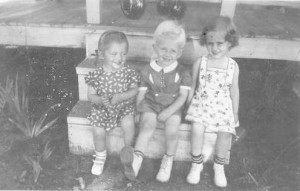
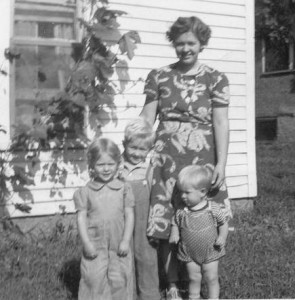
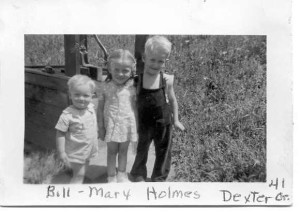
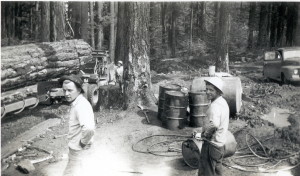
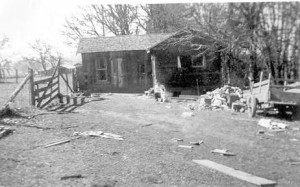
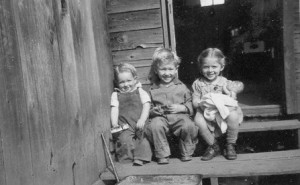
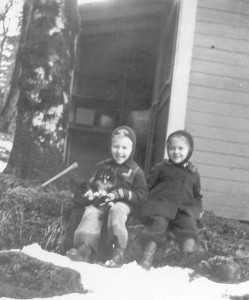
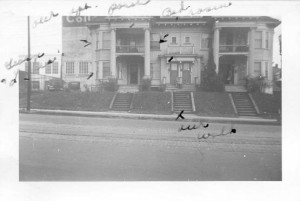
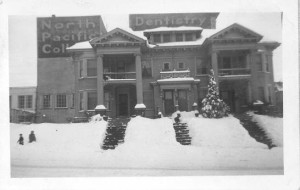
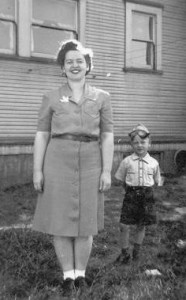
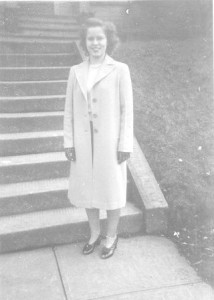
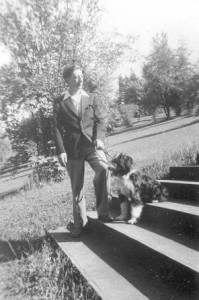
Comments
A lifetime of Homes, Houses and Places: Part I — No Comments
HTML tags allowed in your comment: <a href="" title=""> <abbr title=""> <acronym title=""> <b> <blockquote cite=""> <cite> <code> <del datetime=""> <em> <i> <q cite=""> <s> <strike> <strong>